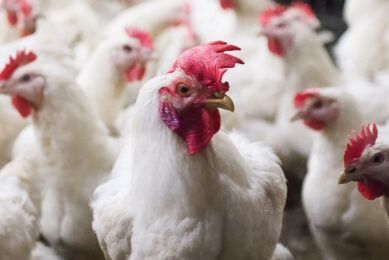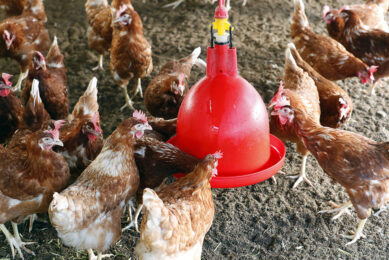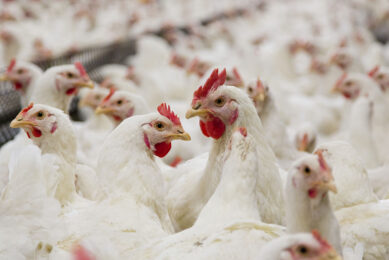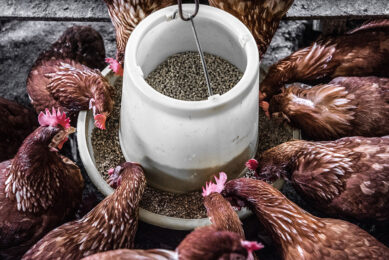Creatine: The energy boost for a healthy start
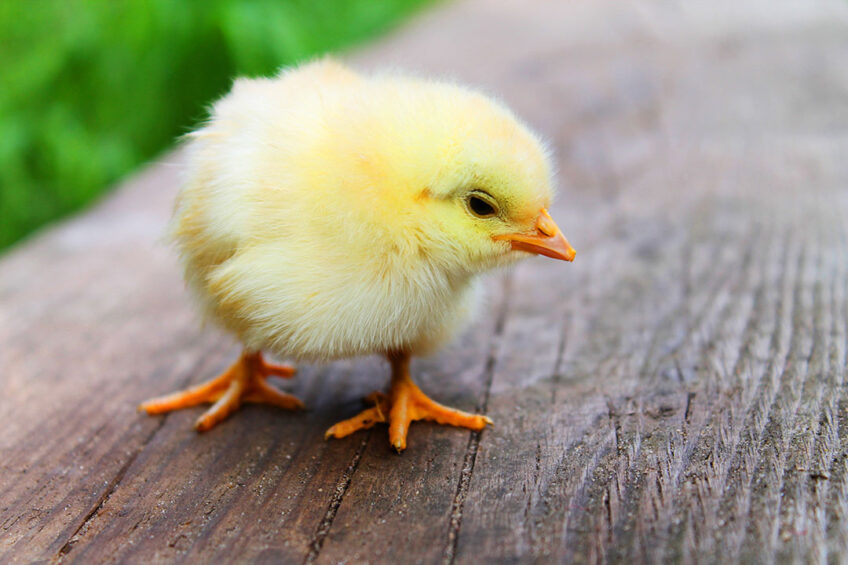
The chick’s first 7 days on-farm play an important role in determining its performance later in life. So what if we could already enrich the embryo with a quickly available energy source to better secure hatching and enhance the first days of the chick’s life? This is possible by feeding the broiler breeder hen a source of creatine.
Creatine might ring a bell for many, as taking creatine as a supplement is very popular among athletes to gain muscle, enhance strength and improve exercise performance.
What is creatine?
Creatine is an organic compound that is naturally produced by 3 amino acids:
- arginine
- glycine
- methionine
This formation occurs in the kidney and liver of vertebrates and is then stored in muscle (mainly) and brain tissue.
What does creatine do?
Creatine gives muscle cells the capacity to produce more energy. This is done through a savvy way of using phosphate groups to convert energy-poor adenosine diphosphate (ADP) back to adenosine triphosphate (ATP), the energy currency of the cell. This is recycling at its best. The result is that the muscle has more energy and can perform better.
Although vertebrates can make creatine themselves, adding creatine in the diet can significantly raise the creatine levels in the body by up to about 20%. This not only provides a surplus of energy, which can be crucial in times of ATP shortage; it can also stimulate cellular glucose uptake followed by an increase in muscle glycogen stores, the next crucial cellular energy reservoir1.
Use of animal derived protein in poultry diets
Because creatine is found in muscle tissue, it is also present in feed ingredients that are based on animal protein. However, concentrations in animal derived proteins are rather low and highly variable, possibly due to variable raw material quality and harsh processing conditions in which creatine is not stable2.
In addition, animal derived proteins are not used that often in animal diets, as most poultry feed formulations are based on vegetable proteins and grains.
Application in poultry feed
Even though creatine can be synthesized by the birds themselves, it is not enough to meet the high demands of modern broilers in terms of performance and growth levels. Creatine supplementation via the diet can therefore be beneficial for poultry. In a way, broilers can be compared with athletes. And this already starts in the embryo phase where there is a constant high demand for energy. Supplying broiler and breeder hens with a source of creatine to boost the creatine levels in the egg and embryo is a great idea. But there is one problem.
Creatine does not like heat
Most poultry feed is supplied in feed pellets. Pelleting is the process of turning raw materials into pellets to make feedstuffs more digestible by breaking down the starches. And this is done at temperatures reaching 80°Celsius. Adding creatine to this process will result in losses of the molecule. Creatine simply doesn’t like heat. A smart way to get around this is by adding the creatine precursor guanidinoacetic acid (GAA) to the mix, which is perfectly equipped to sustain the conditions during feed production. In the liver, guanidinoacetic acid (GAA) can be synthesised into creatine, which is then stored in the muscle tissue.
The embryo has high energy demands
In the last few years, researchers have found that – in addition to glycogen – creatine also plays an important role in the energy supply of the embryo3,4. And it has been confirmed that creatine can be transported from the hen to the egg through the hen’s diet and the hen’s own synthesis of creatine. However, the levels that are transmitted are very low5,3. Murakami found approximately 20 mg/kg DM in the eggs of meat type quail breeder hens. Accounting for a water content of 87% in the egg, this translates to approximately 2.6 mg/kg of the original substance. The growing embryo in the egg starts producing creatine at day 5 of incubation, and production steadily increases as is evident from increasing L-Arginine-Glycine-Amidinotransferase (AGAT) specific activity for GAA formation in the liver5. For whole Hyline White Leghorn embryos, it was reported that approximately 2.62 mg creatine (20 µmol) at day 12 of incubation rose up to 10.5 mg (80 µmol) at day 20 of incubation. This is an increase of over 380% in only 8 days.
So why do embryos need more creatine?
The endogenous synthesis of creatine is imposing an enormous metabolic burden − energy and amino acids that could be also used for muscle protein synthesis. More creatine is demanded to make sure growth is not compromised and the chick is strong enough to hatch and survive the first days after hatching. The chick’s first 7 days on-farm play an important role in determining its performance later in life. So what if we could supplement the breeder hen with creatine and achieve creatine enrichment in the egg and embryo? By doing this, the chick embryo has an extra energy supply available to use for hatching and post-hatch needs. Going for this route is logical because the deposition of nutrients from hen to egg is a natural process and opens up the opportunities to improve hatching rate and chick quality. Little research has been done in this field, even though we know that energy reservoirs such as glycogen6 are crucial for the embryo during the hatching process.
New research on GAA supplementation
Recent research7 conducted in Israel provides fundamental new findings to confirm the creatine transport from broiler breeder hen to chick through GAA supplementation*. The authors studied whether GAA supplementation (15 weeks, 0 or 0.15% GAA) of broiler breeder hens (Cobb 500, 47 weeks of age) affects creatine deposition into the hatching egg. In addition, molecular mechanisms of creatine transport and synthesis within hens and their progeny were investigated via mRNA expression. In this recent study, it was shown that in the hen´s intestinal tract, creatine transporter (CrT) expression was found in duodenum, jejunum and ileum (Figure 1) and all parts of the hen’s reproductive tract (ovary, magnum, isthmus).
Figure 1 – Creatine transporter (CrT) relative expression in hen small intestinal segments after 15 weeks of GAA supplementation.
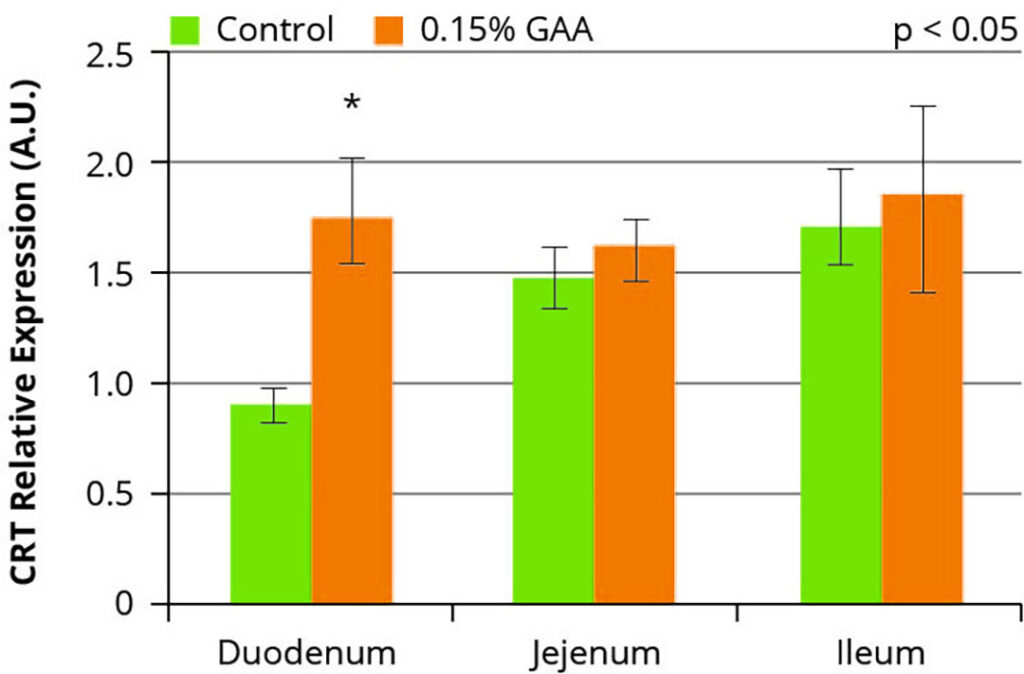
GAA fed hens showed an increased CrT expression in the magnum segment of the breeder hen’s oviduct (Figure 2), probably due to higher creatine levels in the blood of GAA fed birds. CrT was also expressed in the yolk sac tissue (YST) at embryonic day E17, E19 and day of hatch (DOH), indicating that the YST is able to transport the creatine stored in the yolk to the embryonic bloodstream to “feed” the embryo.
Figure 2 – Creatine transporter (CrT) relative expression in hen reproductive tract (magnum) after 15 weeks GAA of supplementation.
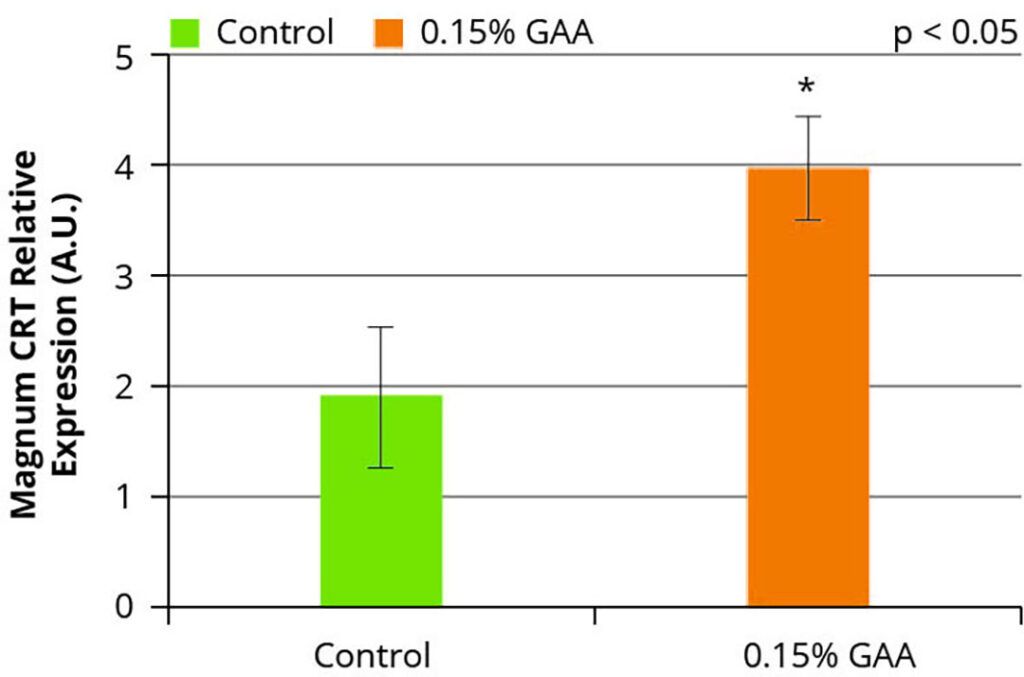
As a preparation for a change in nutrient intake post hatch, CrT expression in the embryonic intestinal tract is substantially increasing from E17 to DOH. Intestinal CrT expression in GAA progenies was a bit reduced, possibly due to elevated substrate availability. Reicher et al
7, reported for the first time CrT expression in hen ovaries and oviducts, as well as in the yolk sac tissue and small intestine of broiler embryos and further specified that when feeding hen GAA in the diet of broiler breeder hens, creatine levels in both yolk and albumen increases. The most pronounced effects were seen in the yolk, which is of primary relevance for embryo development (Table 1). Consequent to the higher yolk creatine levels, expression of creatine synthesis enzymes were down-regulated in the embryo, which is in accordance with the early findings from Ramirez5.
So, the broiler chickens of the GAA fed hens were relieved from endogenous creatine synthesis, thus liberating important amino acids arginine and glycine for protein synthesis and growth. In other word, creatine is extremely welcome for the embryo.
Effect on progeny performance
Reicher and her team’s work showed that, due to dietary GAA (0.15%), total egg creatine could be enriched by more than 40%. These findings in egg creatine are in accordance with earlier studies3, which reported an increase in egg creatine by approximately 30% as a consequence from 0.18% GAA in the meat type quail breeder diet. Murakami also showed that an elevation of egg creatine will lead to elevated muscle creatine levels in the embryo (Figure 3 and 4).
On the findings of this study in quails, the benefits from GAA feeding, to enrich the embryo with creatine, to reduce metabolic burden for creatine synthesis and to supply energy for a good start, are further supported. And the relevance, mainly seen from improved hatchability, is already substantiated by a number of research studies as well as under practical farming conditions (Table 2).
The most effective dose level of GAA was found between 0.08 and 0.12 % GAA. On the basis of the broiler breeder data, benefits were more pronounced in older birds. A practical study including 45,000 birds at high altitude has determined that hens fed 1 g of GAA/kg showed an increase of 1, 3 and 5% in hatchability, compared to hens at the control farm at 60, 61 and 62 weeks of age, respectively9. 2 of the reported studies3,8 showed benefits in progeny performance from GAA fed hens (Table 2). Epstein10 could only detect improved progeny performance when GAA supplementation was also continued during progeny feeding.
Conclusion
There is an increasing body of research exploring the best ways to feed day-old chicks to make sure that they become healthy, fast growing birds. Solutions have been found, such as feeding small, easy-to-eat feed pellets in specially designed feeders that small chicks have easy access to. Enriching the nutritional components in the egg with creatine to better meet the physiological requirements of modern broilers is a very important addition to further improving broiler production in terms of health, growth and efficiency. The latest research with GAA as a source of creatine supports the premise that adding GAA to the diet of broiler breeder hens is a practical and effective way to do this.
*Creamino®, AlzChem Trostberg GmbH, Germany. Creamino contains GAA, which is globally established for growing poultry nutrition while application in breeders is expanding. US approval for GAA has been recently extended to all poultry, including application in breeders.
References 1-10 are available on request.




